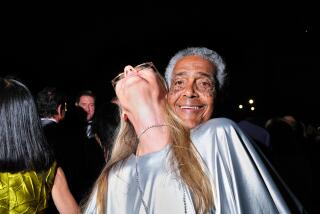Arts Community Calls, and a Rockefeller Answers
- Share via
After decades of upholding the philanthropic traditions of one of the world’s wealthiest families, David Rockefeller could easily turn down yet another social outing.
He often does. “I go to as few as possible,” says Rockefeller, 82, grandson of Standard Oil magnate John D. Rockefeller and brother of former Vice President Nelson A. Rockefeller.
But when he was invited to be guest of honor at a May benefit for the Orange County Museum of Art, Rockefeller couldn’t resist: First, it was being underwritten with a $50,000 donation from Chase Manhattan Bank--he served as chairman and CEO from 1969 until 1980--and second, it was in support of an art museum, his favorite form of philanthropy.
“I think it is very healthy and encouraging that Orange County is not only prosperous but also recognizing the importance of giving its citizens an opportunity to see beautiful works of art,” says Rockefeller, whose mother, Abby Aldrich Rockefeller, was a founder in 1929 of the Museum of Modern Art in New York.
Rockefeller will attend the Art of Dining, an annual benefit--de rigueur for Orange County’s visual arts set--that features a live auction and a multi-course meal prepared by renowned chefs. Gross proceeds from last year’s fund-raiser in Newport Beach were $620,000.
Raised in an atmosphere of privilege, Rockefeller spent childhood at the family’s 3,500-acre estate in Tarrytown, N.Y. The Eyrie, his father John D. Rockefeller Jr.’s summer cottage at Seal Harbor, Me., had 2,280 windows, through which David, his sister and four brothers could gaze upon the world.
Still, his father taught him that vast wealth carried with it vast responsibility.
And so Rockefeller set out to become a businessman and philanthropist in his own right. Today, he is an ambassador for Chase Manhattan Bank and chairman of its International Advisory Committee. He is also chairman emeritus and life trustee of the Museum of Modern Art.
When Rockefeller is traveling on business, says family associate Peter Johnson, he takes time to visit the area’s art museums.
“He loves art museums--pops into them between meetings,” says Johnson, who is writing Rockefeller’s memoir. “And it’s not just a matter of sopping [the art] up--he derives energy and meaning from it.”
In a recent telephone interview from his New York office, Rockefeller talked about the influence of art on his life.
Question: What part did art play in your formative years?
Answer: I grew up with art. In our home, my parents had very beautiful paintings by old masters--both Italian Renaissance and English 18th century portrait painters. My mother, a founder of the Museum of Modern Art in New York, was very interested in art. In my teens, when she was organizing the museum, I got to know many of the people she spoke with, including the museum’s first director.
We also had beautiful things like Gothic tapestries in our home. The Unicorn tapestry that now hangs in the Cloisters [museum in Manhattan] was ours. I enjoyed the artworks very much, and from my parents, I was interested to learn about them.
Q: How did you advance your education in art?
A: I took courses in art history [at Harvard] and visited many museums to see the paintings I had studied. When my mother died in 1948, I was asked to take her place on the board of the Museum of Modern Art, and I did so for years.
Q: What type of art have you collected?
A: With my wife, [Peggy, who died last year], I was fortunate enough over our 55-year marriage to buy some French Impressionist paintings before they got to the astronomical prices they are today. [The collection reportedly includes masterpieces by Cezanne, Gauguin, Pissarro, Picasso, Bonnard, Manet and Matisse.]
Q: What would you say to people about the art museum experience?
A: I would tell them that understanding art comes with looking. Even better, if you can also read about the paintings, have other forms of instruction, that is valuable too. But most important is to see the works. When you look at them over time, you learn to differentiate between the great works and those that are less so.
Q: How does an art museum enrich a community?
A: Mostly, any growing, lively, prosperous community will be better for having in its midst a museum where people can come and enjoy beautiful works of art.
In a world that focuses on the materialistic, on consumption, to have beauty in one’s life is very important.
More to Read
The biggest entertainment stories
Get our big stories about Hollywood, film, television, music, arts, culture and more right in your inbox as soon as they publish.
You may occasionally receive promotional content from the Los Angeles Times.










